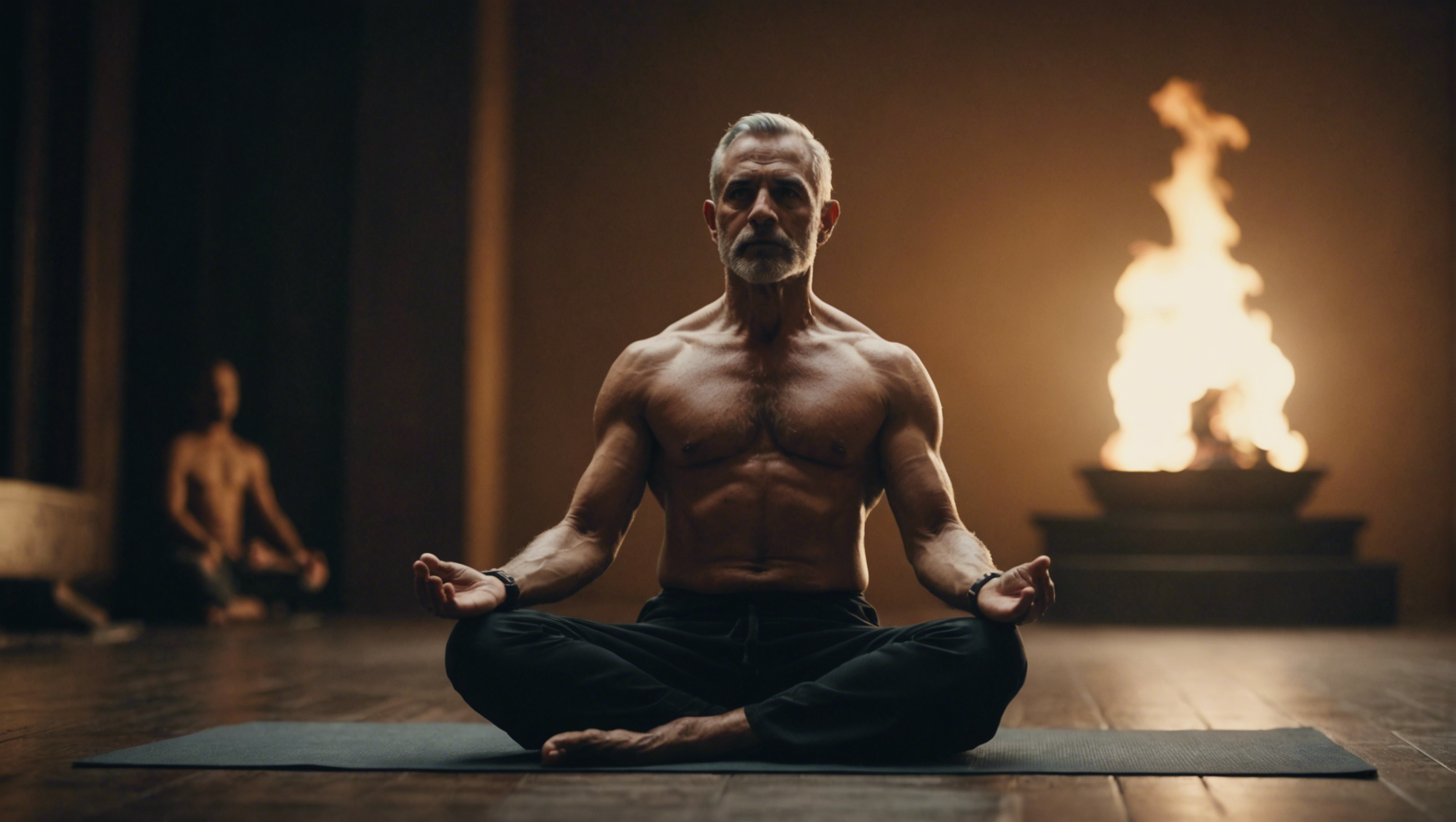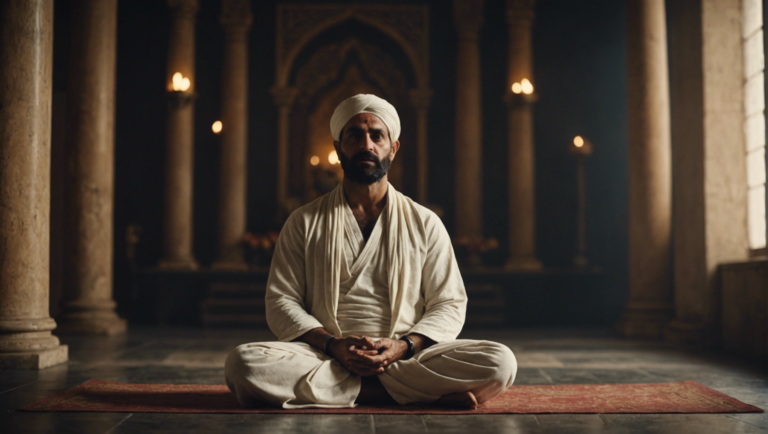Unveiling The Mystery: Who Is The Father Of Yoga?
The Identity of the Father of Yoga: Unraveling the Origins
Unraveling the Origins: A Deep Dive into the Legacy of the Father of Yoga
Yoga, an ancient practice that has seen a meteoric rise in global popularity over the past few decades, stands as a testament to the enduring legacy of its founding fathers. Among these pioneers, one figure is often heralded as the singular father of yoga – Patanjali. His contributions, enshrined in the Yoga Sutras, have shaped the course of Yoga’s evolution, rendering it both a spiritual pursuit and a discipline grounded in the harmony of body and mind. This article seeks to delve into the layers of history and mythology to shed light on the identity of this venerable figure and explore the significance of his teachings in contemporary Yoga practice.
The Historical Patanjali: Scholar, Sage, or Myth?
Patanjali’s existence is shrouded in mystery, with scholars offering divergent views on his historical veracity. Some posit that Patanjali was a real figure who lived sometime between the 2nd century BCE and the 5th century CE. This timeframe corresponds with a period in Indian history marked by significant intellectual and spiritual development. However, in the absence of concrete evidence, others suggest that Patanjali may be a symbolic representation of Yoga’s collective wisdom, rather than an individual. The debate continues, yet what remains undisputed is the monumental impact of the Yoga Sutras.
The Yoga Sutras: A Foundation Stone of Modern Yoga
At the heart of Patanjali’s legacy are the Yoga Sutras, a collection of 196 aphorisms that lay the philosophical framework for the practice of Yoga. The Sutras cover an array of topics, from the nature of reality to the path to spiritual liberation. Among the most significant contributions of the Sutras is the Eightfold Path of Yoga, outlining steps for living a meaningful and purposeful life. This systematic approach to spiritual discipline has influenced countless generations, securing Patanjali’s place as the father of Yoga in the eyes of many practitioners and scholars alike.
The Influence of Patanjali’s Teachings on Contemporary Practice
In the contemporary yoga landscape, the principles set forth by Patanjali continue to resonate. Yoga, as practiced globally today, often emphasizes physical postures (asanas) and breath control (pranayama), principles that are deeply rooted in the Sutras. Moreover, Patanjali’s emphasis on meditation (dhyana) and self-discipline (niyama) finds expression in various forms of modern Yoga, from the rigorously physical ashtanga to the more contemplative hatha. The universal appeal of these principles bears witness to the timeless relevance of Patanjali’s teachings.
The Enduring Legacy and Continuing Debate
The identity of Patanjali and the exact origins of Yoga may remain topics of debate among historians and practitioners alike. Nonetheless, the figure of Patanjali looms large over the Yoga world, embodying the timeless and universal nature of its teachings. Whether viewed as a historical figure, a symbolic representation, or the culmination of collective wisdom, Patanjali’s influence on the practice of Yoga is indelible.
While modern Yoga has evolved in myriad ways, incorporating new techniques and adapting to contemporary health and wellness paradigms, the essence of Yoga, as encapsulated in the Yoga Sutras, remains unchanged. It is this essence that connects today’s Yoga enthusiasts to the ancient traditions and philosophies of a practice that has transcended time and geography.
Reflecting on the Foundations of Yoga Practice
As we engage in Yoga, whether in quiet meditation, the execution of a complex asana, or the simple act of breathing with awareness, we are participating in a tradition that spans millennia. The teachings of Patanjali serve as a bridge from the past to the present, inviting us to explore the depths of our own consciousness and the interconnections of our existence. The identity of the father of Yoga, enigmatic as it may be, reminds us of the profound heritage of this practice and encourages us to approach Yoga with reverence and curiosity, honoring the ancient wisdom that guides us toward well-being and enlightenment.
The Historical Journey of Yoga: From Ancient Wisdom to Modern Practice
The origins of Yoga trace back thousands of years, deeply rooted in the rich soil of ancient India. This spiritual, mental, and physical practice began as a sacred tradition, intertwining meditation, breathing exercises, and postures designed to harmonize the body with the mind and the universe. From the murmurs of Vedic priests to the bustling yoga studios of today’s cities, yoga has embarked on a profound journey, evolving while maintaining its essence. This transformation from ancient wisdom to modern practice reveals not just the adaptability of yoga but its universal appeal across different cultures and epochs.
The Foundations of Yoga in Ancient Texts
Yoga’s first textual mention is found in sacred scriptures known as the Vedas. Composed around 1500 BCE, these texts laid the spiritual groundwork, emphasizing rituals and ceremonies that sought a deeper connection with the divine. However, it was in the Upanishads, a later set of writings, that yoga began to take shape as a defined practice. Here, the concepts of meditation, moral principles, and the pursuit of enlightenment were elaborated, setting the stage for yoga’s development as a discipline for achieving spiritual insight and liberation.
The Systematization of Yoga Practice
Fast forward a few centuries to the creation of the Yoga Sutras by Patanjali, an Indian sage whose work around the 2nd century BCE offered a foundational framework for yoga practice. Patanjali’s Yoga Sutras defined the Eight Limbs of Yoga, including moral disciplines (Yamas), observances (Niyamas), postures (Asana), breath control (Pranayama), sensory withdrawal (Pratyahara), concentration (Dharana), meditation (Dhyana), and finally, enlightenment (Samadhi). This text is pivotal, marking the transition from yoga’s diverse practices and beliefs to a more systematic approach that continues to influence modern yoga today.
The Transition to Medieval Yoga Traditions
In the medieval period, yoga traditions diverged significantly, incorporating tantric elements that focused on the body as a means to enlightenment. This era saw the rise of Hatha Yoga, which emphasized physical postures and breath control, foundational to the yoga practiced worldwide today. Texts like the Hatha Yoga Pradipika elaborated complex techniques not solely for spiritual liberation but for physical and energetic benefits, broadening yoga’s appeal and accessibility.
Yoga’s Journey to the West
The late 19th to early 20th centuries marked the beginning of yoga’s migration to the Western world. Pioneers like Swami Vivekananda played a critical role in introducing yoga to Western audiences, emphasizing its philosophical and meditational aspects. Later, figures such as B.K.S. Iyengar, Pattabhi Jois, and T.K.V. Desikachar would popularize distinct styles of yoga, highlighting the practice’s physical aspects without losing sight of its spiritual roots. This period saw the transformation of yoga into a global phenomenon, integrating into the wellness and fitness movements in the West.
Modern Yoga: A Tapestry of Traditions
Today, yoga is a kaleidoscope of styles and traditions, from the meditative and gentle to the physically demanding. Its evolution continues, fueled by a growing body of research on its health benefits and a worldwide community of practitioners and teachers. Yoga’s ancient principles of mindfulness, breath, and movement resonate more than ever in a world seeking balance and wellness. Its journey from the outskirts of ancient ceremonies to the heart of modern lifestyle and culture stands as a testament to its timeless appeal and adaptability.
The historical journey of yoga, from its Vedic origins to its status as a global practice, is a remarkable tale of endurance, transformation, and transcendence. As yoga continues to evolve, it remains a bridge between the wisdom of the past and the wellness of the future, offering a path to harmony and health that is as relevant today as it was millennia ago.
Patanjali’s Legacy: Illuminating the Yoga Sutras
Delving into the profound depths of Patanjali’s contributions to yoga, we embark on a journey that illuminates the essence and structure of the Yoga Sutras. This ancient text, attributed to the sage Patanjali, is a seminal work that has profoundly influenced the practice and understanding of yoga throughout centuries. As we explore the intricate layers of this philosophical masterpiece, we uncover its significance in modern yoga practice and delve into the wisdom that makes it a cornerstone of spiritual and physical wellness.
The Timeless Wisdom of the Yoga Sutras
Patanjali’s Yoga Sutras are divided into four primary sections or Padas, each unraveling the profound philosophies and practical methodologies of yoga. The sutras outline the path to achieving Kaivalya, or ultimate freedom, marking a journey that transcends the physical to touch the essence of one’s being. The text elegantly synthesizes complex concepts of psychology, metaphysics, and ethics, offering a holistic approach to conquering the mind and attaining enlightenment.
Unveiling the Core Principles of Ashtanga Yoga
At the heart of Patanjali’s teachings lies the Ashtanga Yoga, or the eightfold path. This system provides a structured framework that guides individuals on a transformative journey towards spiritual awakening. Beginning with ethical precepts (Yamas and Niyamas) and advancing through stages of physical postures (Asanas), breath control (Pranayama), and sensory withdrawal (Pratyahara), the practitioner is propelled into the realms of concentration (Dharana), meditation (Dhyana), and ultimately, the state of superconsciousness (Samadhi). By meticulously following this path, one can achieve harmony between the mind, body, and spirit.
The Psychological Insight of the Yoga Sutras
Patanjali’s meticulous analysis of the human mind offers invaluable insights into the nature of thoughts, emotions, and behaviors. By categorizing the vrittis, or mental fluctuations, the Yoga Sutras present a nuanced understanding of psychological well-being and proffer techniques for mastering the inner workings of the mind. The sutras emphasize the power of meditation and mindful awareness in cultivating mental clarity, emotional stability, and a profound sense of inner peace.
The Sutras’ Influence on Modern Yoga Practices
Despite being formulated over two millennia ago, the Yoga Sutras continue to resonate deeply within contemporary yoga practices. The sutras’ comprehensive perspective on ethical living, mental discipline, and spiritual development informs the core principles of various yoga styles today. Yoga teachers and practitioners worldwide draw upon Patanjali’s wisdom to enhance their practices, weaving the ancient philosophies with modern approaches to health and wellness.
Navigating the Challenges of Interpreting the Yoga Sutras
Interpreting the Yoga Sutras presents its set of challenges, given the text’s ancient origins and the complexity of its Sanskrit terminology. Scholars and practitioners alike have undertaken the task of translating and commenting on the sutras, offering diverse interpretations that reflect various philosophical lenses. This plurality of perspectives enriches the study of the sutras, inviting individuals to engage deeply with the text and discover personal meanings within its aphorisms.
Embracing the Legacy of Patanjali in Contemporary Times
In an age where yoga has burgeoned into a global phenomenon, embracing Patanjali’s legacy offers a return to the roots of yogic philosophy. The Yoga Sutras not only provide a foundation for personal growth and spiritual exploration but also foster a deeper connection with the universal principles of harmony, compassion, and mindfulness. By integrating the timeless wisdom of Patanjali’s sutras into our daily lives, we honor the rich heritage of yoga and contribute to its evolving narrative in the 21st century.
Through an in-depth exploration of Patanjali’s Yoga Sutras, we uncover layers of meaning that transcend time and culture, offering insights into the human experience that are as relevant today as they were over two thousand years ago. The legacy of Patanjali illuminates the path towards self-realization, inviting us to engage with the depth of yogic philosophy and practice with renewed vigor and insight.
The Evolution of Yogic Practices Across Cultures
The Roots and Journey of Yoga Across Different Cultures
Yoga, a practice deeply rooted in ancient Indian philosophy, has evolved and spread across the world, integrating itself into various cultures and societies. This transformation over millennia showcases the adaptability and universal appeal of yogic practices, transcending geographical, cultural, and religious boundaries. The journey from its inception to becoming a global phenomenon reflects a rich tapestry of influences, innovations, and interpretations.
Ancient Beginnings and Philosophical Foundations
The origins of yoga can be traced back to the Indus Valley civilization, around 3000 BCE, where archaeologists discovered evidence of postures that resemble modern yoga asanas. However, it was in the ancient Indian scriptures, the Vedas, where the term yoga first appeared. These texts laid the philosophical groundwork, emphasizing meditation, ascetic practices, and ethics, which would later become integral components of yoga.
Yoga’s Migration and Cultural Adaptation
As trade routes expanded, so did the exchange of cultural and spiritual ideas. By the middle period of the first millennium, yoga began to spread beyond India, influencing and being influenced by Buddhist and Jain practices. This period also saw the development of various yoga traditions, each with its unique emphasis, whether on devotion, knowledge, or action.
The Synthesis in the Medieval Era
The medieval era witnessed a synthesis of yogic practices, with texts like the Hatha Yoga Pradipika blending the physical aspects of yoga with its meditative and spiritual core. This era marked the emergence of yoga as a holistic discipline, integrating body, mind, and spirit in the pursuit of enlightenment.
Yoga in the Modern World: A Global Phenomenon
The late 19th and early 20th centuries marked a pivotal moment for yoga, as Indian monks, most notably Swami Vivekananda, introduced yogic philosophy to the Western world. This period saw the reinterpretation of yoga, emphasizing its physical aspects over its spiritual roots, making it accessible to a broader audience.
Contemporary Practices: Diversity and Innovation
Today, yoga has branched into numerous styles, from the traditional Hatha and Raja Yogas to modern adaptations like Power Yoga and Bikram Yoga. This diversity reflects an ongoing process of cultural exchange and adaptation, with practitioners incorporating elements that resonate with their individual and cultural contexts.
The Bridge Between Traditions and Modernity
Yoga’s evolution is a testament to its timeless appeal and adaptability. While it has undergone significant transformation, the core principles of self-realization and mindful living remain unchanged. By weaving together ancient wisdom with contemporary needs, yoga continues to offer a path to physical health and spiritual well-being.
The Future of Yoga: Cross-Cultural Dialogues and Innovations
As yoga’s popularity continues to grow, so does the dialogue between different yogic traditions and modern scientific approaches. This interaction promises not only to enrich yoga with new insights and practices but also to deepen our understanding of health and wellness from a holistic perspective.
Honoring the Roots While Embracing Change
The journey of yoga from ancient India to a global practice is a reflection of humanity’s shared quest for health, happiness, and spiritual fulfillment. As it continues to evolve, embracing the diverse cultures and ideas of its practitioners, yoga remains a bridge connecting the ancient and the modern, the physical and the spiritual, the individual and the universal.
Uniting Cultures Through the Universal Language of Yoga
Ultimately, the evolution of yogic practices across cultures highlights the universal appeal of seeking harmony within oneself and with the world. In this global age, yoga serves as a reminder of our shared humanity, offering a peaceful sanctuary from the complexities of modern life and an anchor in the timeless pursuit of personal and collective well-being.
The Influence of Yogic Principles on Contemporary Wellness Trends
The Resurgence of Ancient Wisdom in Modern Wellness Practices
Yogic principles, dating back thousands of years, have seamlessly woven their essence into the fabric of contemporary wellness trends, influencing not just the physical aspects of health but also the mental, emotional, and spiritual well-being of individuals across the globe. This timeless wisdom, once confined to the sacred texts and teachings of sages, has now found a prominent place in the everyday lives of people seeking balance, harmony, and inner peace in a fast-paced, often chaotic world. The integration of these ancient teachings into modern wellness philosophies offers a holistic approach to living, emphasizing the interconnectedness of body, mind, and spirit.
The Fusion of Yoga with Modern Fitness Regimens
The physical practice of yoga, known as Asana, has been adopted and adapted by fitness enthusiasts worldwide, leading to the emergence of various yoga-inspired fitness trends such as power yoga, hot yoga, and aerial yoga. These modern iterations focus not only on flexibility, strength, and endurance but also incorporate the mindful breathing techniques (Pranayama) and meditative practices at the heart of traditional yoga. This fusion emphasizes the importance of mindfulness and breath control as integral components of physical exercise, enhancing the overall fitness experience and promoting a deeper awareness of the body’s capabilities and limitations.
Mindfulness and Mental Wellness in the Digital Age
In an era where digital distractions and information overload are prevalent, the yogic principle of mindfulness has gained significant traction as a counterbalance to the stresses of modern life. Mindfulness practices, rooted in the meditative traditions of yoga, encourage individuals to cultivate a present-moment awareness, leading to improved concentration, reduced stress levels, and enhanced emotional well-being. This principle has been integrated into various digital wellness platforms, offering guided meditation sessions, mindfulness apps, and online courses designed to help individuals navigate the complexities of contemporary living with serenity and awareness.
The Role of Yoga in Holistic Health Paradigms
The holistic health model, which views health as a multidimensional experience involving the physical, emotional, mental, and spiritual well-being of the individual, has been profoundly influenced by the integrative approach of yoga. This paradigm shift away from a purely biomedical focus towards a more inclusive perspective recognizes the value of yoga as a comprehensive wellness tool. Yoga’s emphasis on self-care, balance, and harmony aligns perfectly with the principles of holistic health, encouraging individuals to take responsibility for their well-being through conscious lifestyle choices, dietary habits, and routine self-reflection.
The Impact of Yogic Diet and Nutrition on Contemporary Eating Habits
The concept of Ahara (diet) in yoga goes beyond mere nutritional intake, advocating for a conscious eating practice that is harmonious with one’s body and the environment. This principle has inspired a growing interest in plant-based diets, ethical eating, and sustainable food practices in the wellness community. The yogic diet, emphasizing whole foods, mindfulness in eating, and the energetic qualities of food, offers a profound perspective on nutrition that resonates with contemporary movements towards health-conscious, environmentally responsible lifestyles.
The Future of Wellness: Integrating Ancient Wisdom and Modern Science
As we look towards the future of wellness, the integration of yogic principles with scientific research and technological advancements promises a new era of health and well-being. With ongoing studies validating the benefits of yoga for physical health, mental clarity, and emotional resilience, the ancient practice continues to gain credibility and popularity in the scientific and medical communities. This fusion of ancient wisdom and modern science paves the way for innovative wellness approaches that honor the wholeness of the human experience, advocating for a balanced, mindful, and conscious way of living in the 21st century.
The influence of yogic principles on contemporary wellness trends represents a bridge between the ancient and the modern, offering timeless wisdom as a foundation for a healthier, more balanced lifestyle. As individuals and communities embrace these teachings, the universal principles of yoga continue to inspire a global movement towards wellness, mindfulness, and holistic living, underscoring the enduring relevance of yoga in the quest for personal and collective well-being.
Conclusion
Navigating through the rich tapestry of history, legends, and teachings, we have embarked on an exploratory journey from the enigmatic origins of yoga to its pervasive influence on today’s wellness landscapes. This exploration has not only unveiled the layers surrounding the identity of the revered sage Patanjali, often celebrated as the Father of Yoga, but has also traced the evolutionary trajectory of yoga from its ancient roots to its present-day global practice.
At the heart of this narrative lies the historical journey of yoga, a voyage that transcends millennia, cultures, and philosophies. What began as a sacred practice embedded within the spiritual fabric of ancient India has flourished into a universal language of harmony, wellness, and self-discovery. This transformation underscores the dynamic and adaptable nature of yoga, an attribute that has enabled its seamless integration into diverse cultures and societies across the globe.
Patanjali’s monumental contribution through the Yoga Sutras offers a foundation that has been instrumental in guiding the evolution of yogic practices. His profound compilation not only illuminates the philosophical underpinnings of yoga but also provides a structured pathway for seekers to achieve spiritual liberation. Patanjali’s work, enriched with wisdom on ethics, meditation, and the very nature of existence, continues to serve as a beacon for practitioners, shaping the core principles that define yoga today.
The narrative further unfolds to reveal the remarkable cross-cultural journey of yogic practices. As yoga traversed geographical boundaries, it embraced new interpretations and adaptations, enriching its repertoire and making it accessible to a broader audience. This cultural osmosis highlights the universal appeal of yoga, affirming its relevance irrespective of ethnic, cultural, or religious affiliations. The adaptability of yoga, evidenced by its harmonious coexistence with diverse traditions, underscores its inclusive essence, catering to the spiritual and holistic needs of humanity at large.
Moreover, the influence of yogic principles on contemporary wellness trends signals a paradigm shift in the collective pursuit of health and well-being. Yoga’s holistic approach, emphasizing the symbiotic relationship between the mind, body, and spirit, has been a guiding light in shaping modern wellness philosophies. The integration of yoga into everyday wellness practices underlines a growing recognition of its potential to foster not only physical well-being but also mental and emotional resilience. This convergence of ancient wisdom and modern science exemplifies the timeless relevance of yoga, offering a holistic blueprint for a balanced and fulfilled life.
Through this exploration, it becomes evident that the essence of yoga transcends the confines of time, space, and identity. Patanjali, while revered as the Father of Yoga, represents the collective wisdom and spirit of countless sages and practitioners who have contributed to the rich heritage of yogic knowledge. The journey of yoga, from its origin to its current stature, is a testament to its enduring allure and transformative power. It invites us into a communal space where the pursuit of self-realization and unity bridges the gap between the individual and the universal.
The narrative that unfolded across the epochs, cultures, and philosophies encountered in this expedition into yoga’s venerable past and vibrant present reminds us that yoga is more than just a practice; it is a living, evolving tradition that nurtures the human spirit in its quest for harmony and enlightenment. As we stand at the crossroads of tradition and modernity, the legacy of yoga, encapsulated in the teachings of Patanjali and the myriad practices that have proliferated across cultures, beckons us to embrace its timeless wisdom. In doing so, we not only honor its illustrious past but also contribute to its ongoing saga, unfolding within the hearts and minds of practitioners around the globe, navigating the eternal flow of existence with grace, strength, and equanimity.



